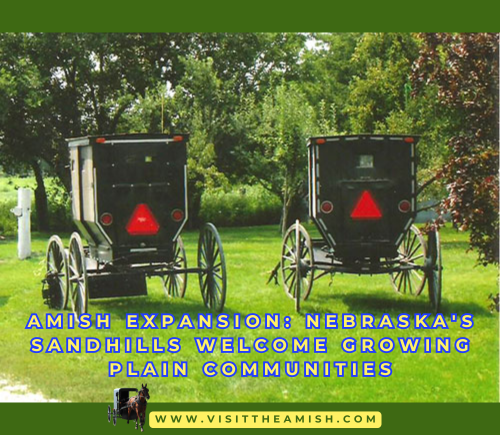The Amish Frontier: Nebraska’s Growing Plain Communities
The serene Sandhills of Nebraska are witnessing a quiet transformation as Amish families establish new roots in this expansive landscape. As of February 2025, the Amish population in Nebraska has surged by 65% since 2020, reflecting a broader trend of Amish expansion across the United States[1][7]. This growth is part of a remarkable demographic phenomenon where the Amish population doubles approximately every 20 years, defying the shrinking family size trend observed in mainstream American society[2][8].
The Kilgore Settlement: A New Amish Frontier
South of Kilgore, near the Niobrara River, a fledgling Amish community is taking shape. James Yoder, who relocated to the area 18 months ago, embodies the pioneering spirit driving this expansion. “We kind of like the West, so that’s why we came back out here,” Yoder explains, having previously lived in Michigan and Indiana[4]. This settlement, currently home to nine families, is expected to grow to about 20 families before reaching capacity.

The Kilgore settlement exemplifies the Amish approach to community growth. When a settlement reaches its optimal size, new communities are established elsewhere, ensuring the preservation of close-knit social structures. Yoder anticipates this pattern will continue: “If that gets full, we’re going to have to spread out to a new area and do that again. That’s probably what will happen.”
Westward Expansion of Amish Communities
While Pennsylvania and Ohio remain strongholds of Amish culture, western states like Nebraska are experiencing a notable increase in Amish settlements[1][4]. This westward migration is reshaping the geographic distribution of Amish communities across North America. “The West is getting more populated with Amish communities,” Yoder observes, highlighting a trend that is likely to continue in the coming years.
Faith, Family, and Enterprise
The Kilgore Amish community, like many others, is built on the foundational pillars of faith, family, and industriousness. Economic activities in the settlement are diverse, reflecting the Amish commitment to self-sufficiency and entrepreneurship. Yoder himself owns Canyon Country Cabins, while other families operate cabinetry shops and saw-sharpening businesses[4].
Agriculture plays a significant role in the community’s economy, with a growing interest in ranching. While some modern equipment like tractors is utilized, the iconic horse-and-buggy remains a common sight, symbolizing the Amish commitment to a simpler lifestyle. “There’s some general construction work and, of course, ranching. There’s a lot of interest in ranching,” Yoder notes.
Education and Community Life
True to Amish tradition, the Kilgore settlement has established its own school where children attend classes through the eighth grade[4]. This approach to education reflects the Amish emphasis on practical skills and community values over formal higher education. “We’re very community-oriented,” Yoder states, underscoring the centrality of communal bonds in Amish life.
The Demographic Phenomenon of Amish Growth
The rapid growth of the Amish population is a subject of fascination for demographers and sociologists. With an average of 6 to 7 children per family, Amish fertility rates are among the highest in the world[2]. This high fertility, combined with a retention rate of about 85% of Amish youth choosing to join the church as adults, fuels the community’s exponential growth[1].
In 2024, the total Amish population in North America reached approximately 400,910, marking an increase of 16,620 from the previous year[1]. This growth is even more remarkable considering it accounts for those who leave the Amish faith. The Amish population has more than doubled since 2000, when it stood at about 177,910[2].
Nebraska’s Amish Landscape
As of 2024, Nebraska is home to seven Amish settlements, with a total estimated population of 585[7]. While this number may seem modest compared to states like Ohio or Pennsylvania, it represents a significant increase from just a few years ago. The state’s vast, affordable land and rural character make it an attractive destination for Amish families seeking to establish new communities.
Challenges and Adaptations
The establishment of new Amish settlements in areas like Nebraska’s Sandhills is not without challenges. Adapting to new agricultural conditions, building relationships with non-Amish neighbors, and maintaining cultural traditions in a new environment require resilience and flexibility. However, the Amish have demonstrated a remarkable ability to thrive in diverse settings while preserving their core values and practices.

Looking to the Future
As Nebraska’s Amish population continues to grow, communities like the one near Kilgore offer a glimpse into the future of Amish settlement patterns. These new frontiers represent not just a geographical expansion, but also the enduring vitality of Amish culture and values in the face of rapid societal changes.
The story of the Kilgore settlement and others like it across Nebraska and the western United States is one of tradition meeting new horizons. As James Yoder and his fellow community members build their lives in the Sandhills, they are writing a new chapter in the ongoing narrative of Amish life in America—one that balances time-honored customs with the pioneering spirit that has long characterized the American West.
Citations:
[1] https://groups.etown.edu/amishstudies/amish-population-profile-2024/
[2] https://www.reddit.com/r/actuary/comments/10cnxmk/amish_population_growth/
[3] https://mre.no/httpdocs/js/zxcvbn/data/english_wikipedia.txt
[4] https://amishamerica.com/amish-nebraska/
[5] https://www.transportation.ohio.gov/wps/wcm/connect/gov/b3b86275-f673-4a2b-b4ae-69a58f82c194/AmishPopulationTrends.pdf?MOD=AJPERES&CONVERT_TO=url&CACHEID=ROOTWORKSPACE.Z18_K9I401S01H7F40QBNJU3SO1F56-b3b86275-f673-4a2b-b4ae-69a58f82c194-nAkqhqh
[6] https://public.ukp.informatik.tu-darmstadt.de/reimers/embeddings/wikipedia_doc_frequencies.txt
[7] https://groups.etown.edu/amishstudies/population-2024/
[8] https://www.youtube.com/watch?v=dqVUc-ju6ck

